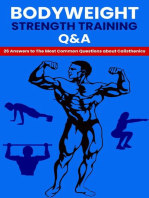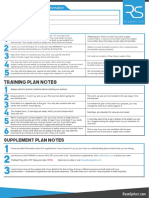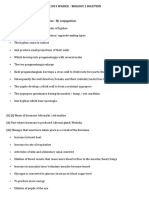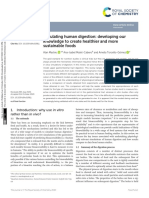Men's Health Pack On Muscle
Men's Health Pack On Muscle
Uploaded by
denby_mCopyright:
Available Formats
Men's Health Pack On Muscle
Men's Health Pack On Muscle
Uploaded by
denby_mOriginal Title
Copyright
Available Formats
Share this document
Did you find this document useful?
Is this content inappropriate?
Copyright:
Available Formats
Men's Health Pack On Muscle
Men's Health Pack On Muscle
Uploaded by
denby_mCopyright:
Available Formats
BUILD MUSCLE
FITNESS
m
QUICK-START GUIDE
Dowdell is a proponent of using more than one
set of joints at a time. He loves squats because
the hips and knees bend simultaneously to exe-
cute the lift. Bigger moves like the squat release
more of the key hormones that increase strength
and muscle and decrease body fat, he says.
Follow this workout and you ll kickstart your
best year in the gym. Stick to it for a month
and you ll lay a foundation for impressive
tness gainsand a pretty good sum-
mer at the beach.
THE 4-WEEK PLAN
Your instructions: Perform this work-
out 3 days a week with at least a day of rest
between sessions. Alternate exercises with the
same number (1A and 1B, for example) until you
complete all of the sets in that pairing. Only
then should you move on to the next pairing.
See below for details.
Weeks 1 and 2
Perform 3 sets of 8 to 10 repetitions
of every exercise except 1A, the hang
clean. For 1A, do 3 sets of 6 to 8 reps.
Rest 60 seconds between all sets ex-
cept the hang-clean ones, after which
you should rest for 90 seconds. Rest
60 seconds between exercise pair-
ings, as well.
W W W. M E N S H E A L T H . C O M
mh
1
R
COPYRIGHT 2008-2009
ARE YOU READY TO BUILD A BIGGER, STRONGER BODY? IN RECORD TIME?
(Beach season is coming, pal.) A total-body workout is scientically proven to increase
muscle gain more efciently than old-school body-part training. Joe Dowdell, C.S.C.S.,
owner of Peak Performance Strength & Conditioning Center, in New York City, developed
the program that follows to help two NBA forwards gain size and strength while also amp-
ing their athletic abilities. The movesdone with weights, reps, and rest periodsunleash
a hormonal cascade that allows any skinny dude to break free from hard-gainer hell.
MUSCLE FACT
17
PERCENTAGE
DECREASE IN
MUSCLE POWER
AFTER 4 WEEKS
OF INACTIVITY
4 HUGE
REASONS TO
LIFT WEIGHTS
LIFTING WEIGHTS 3
DAYS A WEEK CAN...
1. Cut your risk of dia-
betes in just 4 months,
according to a Tufts Univer-
sity study. Weight training
decreases blood-glucose
levels and improves insulin
sensitivity.
2. Treat depression,
according to Harvard
researchers who compared
the benets of weight train-
ing and cardio exercise over
10 weeks. The weight lifters
experienced a greater boost
in mood.
3. Spike your testoster-
one levels by up to 49
percent, according to Finn-
ish scientists. The hormone
plays a key role in your
overall mortality risk and, of
course, your sex drive.
4. Save your brain from
a stroke, according to a
University of Michigan study.
Lifting weights decreases
blood pressure, reducing the
risk of having a stroke by
40 percent.
SOURCE: JOURNAL OF STRENGTH AND CONDI-
TIONING RESEARCH
Aim for a lifting tempo of 2 seconds up and
2 seconds down for exercises 3B, 4A, and 4B.
For 1A, explode up and then go back down in 2
seconds. For each of the others, take 1 second
to go up and 3 seconds to go down.
Weeks 3 and 4
Perform 4 sets of 6 to 8 repetitions of ev-
ery exercise except the hang clean (1A), the
W W W. M E N S H E A L T H . C O M
mh
2
QUICK-START GUIDE
THE EXERCISES
dumbbell curl (3B), and the plate crunch
(4B). For 1A, do 4 sets of 4 to 6 reps; for 3B
and 4B, do 4 sets of 8 to 10 reps each. Use
the same rest-period protocol you used in
weeks 1 and 2.
Your lifting tempo should be 2 seconds
up and 2 seconds down for exercise 3B. For
1A, 4A, and 4B, explode up and go down in 2
seconds. For the others, its 1 second up, 3
seconds down.
WATCH A DEMO OF THE
WORKOUT
MUSCLES TO GO Download
this workout to your iPod at
www.MensHealth.com/download.
Catch the bar in the
crooks of your fingers.
1A
BARBELL HANG CLEAN
Grab a bar with a shoulder-width grip and dip your
knees, as if youre about to jump. Quickly pull the bar up
and rise onto your toes. As the bar approaches chest
height, bend your knees, swing your elbows forward,
and catch it at your shoulders.
A
B
A
1B
DUMBBELL ALTERNATING BENCH PRESS
Lie flat on a bench holding dumbbells over your
chest. Keeping one arm straight, lower the opposing
weight to your shoulder and push it back up. Repeat
with the other arm and continue alternating until
youve completed all your reps.
B
Keep your shoulder blades
pulled back into the bench.
CLICK HERE
W W W. M E N S H E A L T H . C O M
mh
3
QUICK-START GUIDE
2B
NEUTRAL-GRIP PULLUP
Grab the parallel bars of a pullup-bar handle so your hands
face each other. Hang with your arms straight. Pull yourself
up as high as you can, aiming to clear the bar with your chin.
Then slowly lower yourself back to the starting position, at a
full hang.
Dont swing.
Try to keep your body
straight
at all times.
A B
Lower your body
until your thighs are
at least parallel to
the floor.
2A
BARBELL SQUAT
Stand holding a barbell across the back of your
shoulders with an overhand grip, your hands and feet
shoulder-width apart. Keeping your back naturally
arched, bend at the hips and knees to lower your body.
Push back to a standing position.
A
B
THE ANATOMY OF MUSCLE
TENDON Tough connective tissue
that attaches muscle to bone
MYOFIBRIL A collection of thousands
of tiny proteins that together generate
force to help a cell contract
SARCOPLASM A semiuid membrane
that surrounds the myobril and contains
structures, such as mitochondria, that
provide energy for muscular contraction
CAPILLARIES Tiny blood vessels
that deliver nutrients and enzymes
to the muscle bers
MUSCLE A bundle of fascicles that
are enclosed in a sheath of connective
tissue called fascia
FASCICLE A
bundle of several
muscle bers
MUSCLE FIBER A single muscle
cell, which contains several hundred
to several thousand myobrils
SWITCH YOUR GRIP FOR BIGGER BICEPS
To build your arms faster, use these barbell hand-placement tips from strength coach Bill Hartman, P.T., C.S.C.S. The slight adjustments in grip
will allow you to target both heads of the bicepsthe long and shortfor optimal growth. Choose one exercise for each head, and alternate
sets and reps each workout, doing either 2 sets of 12 reps, 4 sets of 6, or 3 sets of 8.
QUICK-START GUIDE
Lower the weights as far as
you can while maintaining
the arch in your lower back.
3A
DUMBBELL ROMANIAN DEADLIFT
Stand holding a dumbbell in each hand in front of your
thighs. Maintaining the natural arch in your spine and
keeping the weights close to your body, push your hips back
and lower the weights. Squeeze your glutes and return to
the starting position.
Avoid using momentum
to curl the weight up.
Stand tall.
3B
DUMBBELL CURL TO OVERHEAD PRESS
Stand holding dumbbells down at your sides with your palms
forward. Curl the weights up to your shoulders. Next, rotate
your wrists as you press the dumbbells overhead so your
palms face forward at the top. Reverse the move back to the
starting position.
A
B
A B C
YOUR TARGET The long head of the biceps
Option 1: The close-grip curl
Grab the bar with a narrow, underhand grip,
your hands about 8 inches apart.
W W W. M E N S H E A L T H . C O M
mh
4
Option 2: Reverse curl
Grab the bar with an overhand grip, your
hands about shoulder-width apart.
Wide-grip curl
Grab the bar with
an underhand, beyond-
shoulder-width grip.
YOUR TARGET The short head of the biceps
W W W. M E N S H E A L T H . C O M
mh
5
QUICK-START GUIDE
4A
HALF-KNEELING CABLE LIFT WITH ROPE
Attach a rope handle to a low-pulley cable; assume a
half-kneeling position perpendicular to the weight stack.
Rotate your torso toward the stack and grab the rope with
both hands. Explosively rotate away, raising your arms.
Return to the starting position.
Keep a slight
bend in
your elbows
throughout the
move.
A
B
4B
SWISS-BALL PLATE CRUNCH
Lie on a Swiss ball so your back curves over it. Hold a weight
plate at your chest. Curl your body up and slightly forward,
lifting your shoulder blades off the ball. Pause at the top and
then slowly lower yourself back to the starting position.
Keep your head
and neck in line
with your spine.
B
A
TAKE THE TOTAL-BODY ROUTE FOR FASTEST GAINS
Performing total-body workouts three times a
week is the most effective way to gain muscle, says
Alwyn Cosgrove, owner of the Results Fitness gym,
in Santa Clarita, California. Unfortunately, that ad-
vice directly contradicts what most guys actually do
because they subscribe to old notions about weight
lifting: what Cosgrove calls body-part training.
The idea there is to divide the body into specic
muscle groups and dedicate an entire session to
working each individually. With total-body workouts,
though, you work each muscle more often. When
you train a muscle three times a week, it spends
more total time growing, says Cosgrove.
Anatomically speaking, you cant isolate muscle
groups in the rst place. Muscles are intercon-
nected, surrounding the body like a unied web and
enclosed in a tough connective tissue called fascia
(see page 3). And since fascia attaches to bone and
other muscles, it creates functional relationships
between seemingly separate muscle groups.
Even a small movement of your upper arm
triggers a complicated network of muscles from
your shoulder down to your hip, says Bill Hartman,
P.T., C.S.C.S., a physical therapist in Indianapolis.
Heres why: The latissimus dorsi (or lat), the larg-
est muscle of the back, attaches to the upper-arm
bone, shoulder blade, spine, and thoracolumbar
fasciawhich attaches muscles to the spine and
pelvis. The glutes, or rear hip muscles, attach to the
pelvis. See the connections?
the 4-week muscle plan
W E E K S 1 & 2
EXERCI SE Date Reps Tempo: Up/Down Rest
1A. Barbell Hang Clean 6-8 Explode/2 s 60 s
SET 1
SET 2
SET 3
1B. Dumbbell Alternating Bench Press 8-10 1 s/3 s 60 s
SET 1
SET 2
SET 3
2A. Barbell Squat 8-10 1 s/3 s 60 s
SET 1
SET 2
SET 3
2B. Neutral-Grip Pullup 8-10 1 s/3 s 60 s
SET 1
SET 2
SET 3
3A. Dumbbell Romanian Deadlift 6-8 1 s/3 s 60 s
SET 1
SET 2
SET 3
3B. Dumbbell Curl to Overhead Press 8-10 2 s/2 s 60 s
SET 1
SET 2
SET 3
4A. Half-Kneeling Cable Lift w/ Rope 8-10 2 s/2 s 60 s
SET 1
SET 2
SET 3
4B. Swiss-Ball Plate Crunch 8-10 2 s/2 s 60 s
SET 1
SET 2
SET 3
Perform this workout 3 days a week with at least a day of rest between sessions. Alternate
exercises with the same number (1A and 1B, for example) until you complete all of the sets in
that pairing. Only then should you move on to the next pairing. See below for details.
W W W. M E N S H E A L T H . C O M
mh
6
QUICK-START GUIDE
INJURY-PROOF
YOUR WORKOUT
Fitness should boost your body, not
break it down. Most nagging injuries
are caused by pressure, friction,
or tension, says Sean Collins, P.T.,
Sc.D., physical therapy chairman at
the University of Massachusetts at
Lowell. Adjust your approach with
the following tweaks.
PROBLEM:
Discomfort from the squat bar
CAUSE: The metal bar, combined
with the pressure of the weight and
insufcient cushioning, can rub the
bony vertebra at the base of your
neck.
FIX: Position the bar a half inch
to an inch lower than you usually
would, to take pressure off the bony
protrusion, says Joseph M. Warpeha,
director of the exercise physiology
laboratories at the College of St.
Scholastica. If the bar has no pad-
ding, wrap a gym towel around it or
swap in a pair of dumbbells.
PROBLEM: Tender skin after
doing pullups
CAUSE: The portion of thicker esh
just below your ngers jams beneath
the pressure of the bar, pinching with
every shift in weight.
FIX: To reduce impact, slide your
hand up to the bar to push the eshy
part down and out of the way, says
Collins. Be sure to grip the bar at the
crease where your ngers meet your
palms, and then wrap your ngers
around it.
PROBLEM: Deadlift shin scrapes
CAUSE: The rough gripping area of
the bar (called the knurling) drags
against your legs as you lift, grating
your skin.
FIX: Before liftoff, position your
shoulders in front of the bar and
your shoulder blades directly over
the bar, says Alexander Koch, Ph.D.,
an associate professor of health
and exercise sciences at Truman
State University, in Missouri. Youll
avoid pulling the bar into your shins,
resulting in a cleaner, safer lift.
If your biceps just dont seem to grow, try starting your workout with arm curls. Brazilian researchers deter-
mined that placing an exercise rst in your workout allows you to complete more repetitions of the move with
a given weight. This means youre doing more physical work, which is the key to building more muscle, says
Alexander Koch, Ph.D., an exercise scientist at Truman State University.
TIP GROW BIGGER GUNS
the 4-week muscle plan continued
W E E K S 3 & 4
EXERCI SE Date Reps Tempo: Up/Down Rest
1A. Barbell Hang Clean 6-8 Explode/2 s 60 s
SET 1
SET 2
SET 3
1B. Dumbbell Alternating Bench Press 8-10 1 s/3 s 60 s
SET 1
SET 2
SET 3
2A. Barbell Squat 6-8 Explode/2 s 60 s
SET 1
SET 2
SET 3
2B. Neutral-Grip Pullup 8-10 1 s/3 s 60 s
SET 1
SET 2
SET 3
3A. Dumbbell Romanian Deadlift 6-8 Explode/2 s 60 s
SET 1
SET 2
SET 3
3B. Dumbbell Curl to Overhead Press 8-10 1 s/3 s 60 s
SET 1
SET 2
SET 3
4A. Half-Kneeling Cable Lift w/ Rope 6-8 Explode/2 s 60 s
SET 1
SET 2
SET 3
4B. Swiss-Ball Plate Crunch 8-10 1 s/3 s 60 s
SET 1
SET 2
SET 3
W W W. M E N S H E A L T H . C O M
mh
7
QUICK-START GUIDE
MUSCLE FACT
19
PERCENTAGE INCREASE
IN ARM STRENGTH YOULL
DEVELOP BY PERFORMING
CARDIO AFTERNOT BE-
FORELIFTING WEIGHTS
SOURCE: JOURNAL OF APPLIED PHYSIOLOGY
Taking time off between workouts doesnt make you lazyit makes you smart. Ball State University scientists
found that the muscle damage caused by pumping iron saps your strength for up to 2 days. In fact, lifters who
didnt wait at least 48 hours between bench-press workouts saw a signicant drop in the number of reps they
could perform. Resting a muscle group properly allows it to heal completely, which is part of the growth pro-
cess, says Larry Judge, Ph.D. And strength is a great gauge: If youre weaker from one workout to the next, you
need more recovery time. Of course, you can still train on back-to-back days, as long as youre working different
musclesupper body one day and lower body the next, for example.
TIP GIVE IT A REST
MUSCLE SCIENCE
HOW RESISTANCE MAKES
YOU STRONGER
The biology of muscle isnt rocket
science. At its most basic level is the
SAID principle, an acronym for specic
adaptation to imposed demand. When
a muscle contracts against a large
amount of resistance, it adapts by get-
ting bigger and stronger, says Vincent
Caiozzo, a professor of orthopedic sur-
gery at the University of California at
Irvine, whos been studying muscle for
nearly 30 years. Likewise, if a muscle
is regularly forced to contract for
long periods of time, it becomes more
resistant to fatigue. These adaptations
occur to reduce stress on the body,
which is why you can perform everyday
functions, like walking up stairs or pick-
ing up a light object, with little effort.
Now lets apply the SAID principle
to your workout. When you lift weights,
you cause tiny tears in your muscle -
bers. This accelerates a process called
muscle-protein synthesis, which uses
amino acids to repair and reinforce
the bers, making them resistant to
future damage. And although this hap-
pens at a microscopic level, the effect
becomes visible over timein the form
of bigger arms, broader shoulders, and
a thicker chest.
Understanding this process provides
you with a logical rationale for how
often you should train your muscles.
In multiple studies, researchers at the
University of Texas Medical Branch in
Galveston have reported that muscle-
protein synthesis is elevated for up to
48 hours after a resistance-training
session. So if you work out on Monday
at 7 p.m., your body is in muscle-
growth mode until Wednesday at 7
p.m. After 48 hours, though, the bio-
logical stimulus for your body to build
new muscle returns to normal.
W W W. M E N S H E A L T H . C O M
mh
8
QUICK-START GUIDE
8
MISTAKES THAT COST MUSCLE
AVOID THESE COMMON GYM GAFFES TO GET STRONGER
exercise. If possible, have a trainer or knowl-
edgeable friend evaluate your form. Strive
for perfection on each repetition. Once per-
fect form for that exercise becomes second
nature to you, youll reap greater gainswith
fewer injuriesfrom your normal workouts.
4
YOU RUN TOO MUCH. A
little runningabout 20 minutes on
the days following your weight-lifting
sessionscan help you recover from
your workouts faster. But a lot of running
can prevent your body from gaining muscle
and strength. One possible reason: Running
damages your lower-body muscles, and ex-
ercise-induced muscle damage signicantly
decreases leg strength, according to a study
published in the Journal of Sports Science.
Dont run or cycle the day before a weight
workout in which you plan to work your leg
muscles. You can do a light run the day af-
ter a leg workout, but a hard run will prob-
ably undo the benets of the weight work-
out. Dont train for a triathlon or marathon
while youre trying to build serious muscle
and strength.
5
YOU USE INCORRECT
FORM. Mirrors are in gyms for a
reason: Theyre the easiest way for
you to monitor your form and avoid
injury. Heres one sign youre doing an ex-
ercise wrong: The barbell isnt parallel to
the oor. If its tilted to one side, youre ap-
plying more force with one arm or leg than
the other. Keep your movement precise and
consistent throughout each repetition. An-
other tip-off: Your lower back is rounded.
This isnt a mistake in all exercises (you have
to round your back to do most abdominal
exercises properly), but it shouldnt happen
during squats, deadlifts, or rows.
1
YOU DO THE SAME OLD
EXERCISES. Muscles get bigger and
stronger when theyre challenged with new
exercises and techniques. All exercises have
an expiration date. If an exercise uses more
than one joint (for example, the bench press
uses the shoulders and elbows; the squat uses
the hips and knees), you can do it for 8 weeks
before you should switch to another exercise
for the same muscles. If it involves a single
joint (biceps curl, triceps pushdown, lateral
raise), nd a substitute after just 4 weeks.
2
YOU DONT USE A
TRAINING LOG. Its hard to
break records that dont exist. So in-
vest in a clipboard, gin up a training
log, and track your progress. Then focus on
lifting more total weight each workout. Its
the key to building muscle. Heres how: Mul-
tiply the amount of weight you lift for each
exercise by the total number of times you
lift it. Increase that number every workout
by moving heavier weights, increasing your
repetitions, or doing more sets. So if in your
last workout you did three sets of 10 reps of
the bench press with 150 pounds, your total
to beat is 4,500. Accomplish that goal by do-
ing four sets instead of three, 11 reps instead
of 10, 155 pounds instead of 150, or a combi-
nation of the three. And write it down.
3
YOU HAVE A BIG EGO. Its
a product of our natural inclination to
be better than the other guy. But the
only way heavy weights benet your
end goal is if you lift them with perfect form.
Heres an ego-xing drill: Once a month, do
10 sets of a single repetition of an important
exercise such as the bench press, squat, or
deadlift. Use about two-thirds of the maxi-
mum weight youre capable of lifting on that
6
YOU WARM UP ON A
TREADMILL. Warming up by
running on a treadmill or pedaling
an exercise bike prepares only the
muscles of your lower body to lift. A bet-
ter way to warm up is to focus on the spe-
cic muscles youll be using in your weight
workout. For your lower body, warm up
with squats. For your upper body, a com-
bination of bench presses and rows. Start
with a weight that you gure you can lift
15 to 20 times, but perform only six reps.
Wait 30 seconds, increase the weight to an
amount you can lift just 10 to 15 times, and
do four reps. Rest again, increase the weight
to an amount you can lift ve to 10 times,
and do two reps.
7
YOU PLAY TO YOUR
STRENGTHS. Its human nature
to spend more time on the muscles
that work besta dangerous mistake.
A 2002 study found that 70 percent of men
with recurrent hamstring injuries suffered
from muscle imbalances between their quad-
riceps and hamstringsthe muscles of the
front and back of the thighs. After correcting
the imbalances with equal training for both
areas, every man in the study went injury-
free for the entire 12-month follow-up.
8
YOU TRY TOO HARD. Work-
ing your muscles to failure isnt the best
way to get bigger and stronger. As your
muscles fatigue, they use fewer fast-
twitch bers, which have the greatest potential
for size and strength gains. For most exercises
theres an easy x: You can simply use a weight
that allows you to nish all of your repetitions.
But body-weight exercises like chinups dont
allow that luxury. The solution: Cut your rep-
etitions in half and double the number of sets
you do.
You might also like
- Deadly Dozen Training ManualDocument259 pagesDeadly Dozen Training Manualsathickjaffer208No ratings yet
- Plan Ebook SK Hiit Plan2Document23 pagesPlan Ebook SK Hiit Plan2thrNo ratings yet
- Donut Business Operational Manual (Updated)Document47 pagesDonut Business Operational Manual (Updated)denby_mNo ratings yet
- Win The War On Fat (10 of 10)Document2 pagesWin The War On Fat (10 of 10)Cal4No ratings yet
- MH June06 PosterDocument2 pagesMH June06 PosterN1c0l4100% (5)
- John Cena Workout PDFDocument1 pageJohn Cena Workout PDFruben100% (1)
- Second Year ENG PDFDocument40 pagesSecond Year ENG PDFRajula Gurva Reddy75% (4)
- Mens Health Personal Trainer PDFDocument11 pagesMens Health Personal Trainer PDFlatifpsh733No ratings yet
- The Simple Guide to Kettlebell Training: Learn Kettlebell Exercises for Fat Loss and Muscle BuildingFrom EverandThe Simple Guide to Kettlebell Training: Learn Kettlebell Exercises for Fat Loss and Muscle BuildingNo ratings yet
- Bodyweight Strength Training Q&A: 26 Answers To The Most Common Questions About CalisthenicsFrom EverandBodyweight Strength Training Q&A: 26 Answers To The Most Common Questions About CalisthenicsNo ratings yet
- 101 Fat-Burning Workouts & Diet Strategies For Men: Everything You Need to Get a Lean, Strong and Fit PhysiqueFrom Everand101 Fat-Burning Workouts & Diet Strategies For Men: Everything You Need to Get a Lean, Strong and Fit PhysiqueRating: 3 out of 5 stars3/5 (1)
- Cover Model TransformDocument18 pagesCover Model Transformcrespo123456No ratings yet
- Add 2 Inches To Your Arms (8 of 10)Document2 pagesAdd 2 Inches To Your Arms (8 of 10)Cal4100% (3)
- 30 Days To Six-Pack Abs: Search Articles, Products, BrandsDocument12 pages30 Days To Six-Pack Abs: Search Articles, Products, BrandscharisNo ratings yet
- The Celebrity Workouts and Diets Book: Packed Full Off Workout Routines and Nutritional InformationDocument24 pagesThe Celebrity Workouts and Diets Book: Packed Full Off Workout Routines and Nutritional Informationtotally_gnar100% (2)
- Andrew Gym Power Fat-Blasting ProgramDocument32 pagesAndrew Gym Power Fat-Blasting ProgramAndrew EscagedaNo ratings yet
- 1 Goblet SquatDocument6 pages1 Goblet SquatVish RughooburNo ratings yet
- MP Getswole Phase1-4-Bb PDFDocument26 pagesMP Getswole Phase1-4-Bb PDFPăun CristiNo ratings yet
- True Muscle CalendarDocument3 pagesTrue Muscle Calendarjn001072100% (1)
- 100 Workouts 2015Document209 pages100 Workouts 2015Christian López MasNo ratings yet
- Dino Petkovic 8 Week Program 1/1Document8 pagesDino Petkovic 8 Week Program 1/1Ivan GavrilovicNo ratings yet
- Kiss Bence Ultimate Beginners Guide Street WorkoutDocument48 pagesKiss Bence Ultimate Beginners Guide Street WorkoutEl FlamingoNo ratings yet
- Dyson, Stanford - Fitness Over 50 - Complete Step-by-Step Guide To Become Lean, Muscular and in The Best Shape Ever With Exact Weekly Workout Plan (2021) - Libgen - LiDocument89 pagesDyson, Stanford - Fitness Over 50 - Complete Step-by-Step Guide To Become Lean, Muscular and in The Best Shape Ever With Exact Weekly Workout Plan (2021) - Libgen - LiMeriç TemurNo ratings yet
- ABS EbookDocument12 pagesABS EbookLouis Edge0% (1)
- Wa0081Document12 pagesWa0081Violeta del pilar VázquezNo ratings yet
- Fat ShredderDocument2 pagesFat ShredderStojan Bajraktarov100% (2)
- Cross Fit - Benchmark Workouts PDFDocument5 pagesCross Fit - Benchmark Workouts PDFThiago LealNo ratings yet
- Rutina Marzo2012Document11 pagesRutina Marzo2012Denisse Andrade LeyvaNo ratings yet
- Training Guidelines Long Distance RunningDocument3 pagesTraining Guidelines Long Distance RunningBjörn Þór SigurbjörnssonNo ratings yet
- Jack D Coulson - 10 Weeks To Rapid Fat Loss - The Most Effective Strategy For Losing Fat Quickly-Independently Published (9 May 2019)Document22 pagesJack D Coulson - 10 Weeks To Rapid Fat Loss - The Most Effective Strategy For Losing Fat Quickly-Independently Published (9 May 2019)choekeehongNo ratings yet
- Phiq099 Physical Iq Afaa Prospectus 6Document15 pagesPhiq099 Physical Iq Afaa Prospectus 6tesfamichael100% (1)
- Boot Camp DownloadDocument3 pagesBoot Camp DownloadsripathicNo ratings yet
- Sample Fat Burning WorkoutDocument19 pagesSample Fat Burning WorkoutogautierNo ratings yet
- 30 Day Workout PlanDocument8 pages30 Day Workout PlanJerome JarrettNo ratings yet
- Official Athlete Guide: 23 OUTUBRO 2021 Cascais, PortugalDocument36 pagesOfficial Athlete Guide: 23 OUTUBRO 2021 Cascais, PortugalBibiNo ratings yet
- 151426835-Pullup-Basic-Poster-web Copy-2Document1 page151426835-Pullup-Basic-Poster-web Copy-2Alberto CanoNo ratings yet
- Ultra Fitness Mag 2014-02-03Document132 pagesUltra Fitness Mag 2014-02-03Raphael Doukkali50% (2)
- The Perfect Summer Shred: Workouts and CardioDocument7 pagesThe Perfect Summer Shred: Workouts and CardioJeremiahgibsonNo ratings yet
- A Linear Progression Based PPL Program For Beginners - FitnessDocument7 pagesA Linear Progression Based PPL Program For Beginners - FitnessumarzulqarnainNo ratings yet
- MH July06 PosterDocument2 pagesMH July06 PosterN1c0l4100% (5)
- Month 1 NutritionDocument4 pagesMonth 1 NutritionshadywonNo ratings yet
- CW Website Free ReportDocument18 pagesCW Website Free ReportMandy AbregoNo ratings yet
- Marathon Training Plan Miles 3-29-2016Document31 pagesMarathon Training Plan Miles 3-29-2016Carlos Pizano MartínezNo ratings yet
- 12 Week Free Bodybuilding Program Accessory WODs 1Document1 page12 Week Free Bodybuilding Program Accessory WODs 1berkNo ratings yet
- Muscle Fitness Summer 2014 Training TrendsDocument94 pagesMuscle Fitness Summer 2014 Training TrendsOrlandoBoxingNo ratings yet
- Dup TemplateDocument5 pagesDup TemplateJoshua SouthNo ratings yet
- P90X3 Calendar DoublesDocument1 pageP90X3 Calendar DoublesCarlos AlejandroNo ratings yet
- 8 Week Shred 1470077297538Document2 pages8 Week Shred 1470077297538Jesus Castro Machuca0% (1)
- Body Making Food - Google SearchDocument1 pageBody Making Food - Google SearchmohanmedzayanmzNo ratings yet
- Heart Rate TrainingDocument3 pagesHeart Rate TrainingNetravathi EllurNo ratings yet
- FREE Program 2019Document14 pagesFREE Program 2019aganayanNo ratings yet
- Half IRONMAN 70.3 - 12 WeeksDocument31 pagesHalf IRONMAN 70.3 - 12 Weeksjai JeeNo ratings yet
- The Body-Balance Workout by Marc LebertDocument5 pagesThe Body-Balance Workout by Marc Lebertwaxguru100% (1)
- Antique Trader Magazine 06Document64 pagesAntique Trader Magazine 06denby_mNo ratings yet
- Bing Tart RecipeDocument1 pageBing Tart Recipedenby_mNo ratings yet
- Cinemagic v1 10Document33 pagesCinemagic v1 10denby_mNo ratings yet
- Cinemagic v1 11Document33 pagesCinemagic v1 11denby_mNo ratings yet
- Champion Sports Gymnastics CatalogDocument31 pagesChampion Sports Gymnastics Catalogdenby_m100% (1)
- Champion Sports Band CatalogDocument27 pagesChampion Sports Band Catalogdenby_mNo ratings yet
- Automata - Old & NewDocument147 pagesAutomata - Old & Newdenby_mNo ratings yet
- DK Mysteries of The UniverseDocument5 pagesDK Mysteries of The Universedenby_m100% (1)
- Queen Winter Ebook 2021Document26 pagesQueen Winter Ebook 2021denby_m100% (1)
- COVID 19 Ab Fact SheetDocument4 pagesCOVID 19 Ab Fact Sheet10tenharmonyNo ratings yet
- AriocarpusDocument3 pagesAriocarpus林杰No ratings yet
- PassifloraDocument23 pagesPassifloraFernandoNo ratings yet
- Structure and Function of MacromoleculesDocument19 pagesStructure and Function of MacromoleculesMaretaNo ratings yet
- Sex and Gender ReportDocument30 pagesSex and Gender ReportFerlynne Marie BernardinoNo ratings yet
- AUBF Microscopic Exam Part 2&3Document13 pagesAUBF Microscopic Exam Part 2&3Anya IgnacioNo ratings yet
- 2017 Supplement Guide: Muscle Building, Strength, RecoveryDocument14 pages2017 Supplement Guide: Muscle Building, Strength, RecoverySuhail Mohammad ZargarNo ratings yet
- Trematode SDocument26 pagesTrematode SothnielNo ratings yet
- Eriochrome Black T Msds PDFDocument2 pagesEriochrome Black T Msds PDFDonaldNo ratings yet
- Handbook On Orchid CultivationDocument26 pagesHandbook On Orchid CultivationlanamkNo ratings yet
- Nervous System: Name: - Class: - DateDocument20 pagesNervous System: Name: - Class: - DateKesithan AnandarashNo ratings yet
- Autonomic Nervous SystemDocument15 pagesAutonomic Nervous SystemJhara100% (2)
- Fish Breeding and GeneticsDocument7 pagesFish Breeding and GeneticschechayvenzNo ratings yet
- Aabb Technical Manual 18th EdDocument901 pagesAabb Technical Manual 18th Ednathanmrrk pacayNo ratings yet
- 2015 Wassce - Biology 2 SolutionDocument9 pages2015 Wassce - Biology 2 SolutionKelvin Yeboah TenkorangNo ratings yet
- Habitat Requirements of Wildlife: Food, Water, Cover and SpaceDocument5 pagesHabitat Requirements of Wildlife: Food, Water, Cover and SpaceSamuel Edwin PizarroNo ratings yet
- Second Quarterly Exam in Earth and Life Science - 2023-2024.Document2 pagesSecond Quarterly Exam in Earth and Life Science - 2023-2024.RODULFO V. PAQUINGANNo ratings yet
- Transport in Plants. CAPE Biology.Document5 pagesTransport in Plants. CAPE Biology.Rocheal WhittinghamNo ratings yet
- Crop Protection - 100 Q A Set ADocument7 pagesCrop Protection - 100 Q A Set AAileen Gale Solis100% (1)
- GlucosinolatosDocument17 pagesGlucosinolatosClara Suárez MartínezNo ratings yet
- Food TestDocument6 pagesFood Testkemi gittensNo ratings yet
- Genetic Tools For Manipulating Acinetobacter Baumannii Genome: An OverviewDocument13 pagesGenetic Tools For Manipulating Acinetobacter Baumannii Genome: An OverviewKlauss Castillo PardoNo ratings yet
- Histology NotesDocument38 pagesHistology Notesyigermalamanuel32No ratings yet
- Science 10 - Quiz 1 - Q3W1Document1 pageScience 10 - Quiz 1 - Q3W1ChelleNo ratings yet
- Weather and Season WorksheetDocument3 pagesWeather and Season Worksheetregata4100% (3)
- Simulating Human DigestionDocument35 pagesSimulating Human DigestionLIBARDO CASTAÑEDA FLOREZNo ratings yet
- Examples For Autotrophs That Uses Chemosynthesis - Google SearchDocument1 pageExamples For Autotrophs That Uses Chemosynthesis - Google Searchn9hhb88r95No ratings yet
- Đáp án 231 câu trắc ngiệm giới từDocument11 pagesĐáp án 231 câu trắc ngiệm giới từFunny OfficialNo ratings yet
- Weekly Plan3 - TNDocument37 pagesWeekly Plan3 - TNABDULGAFFAR MNo ratings yet



































































































